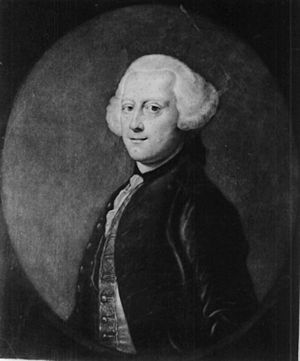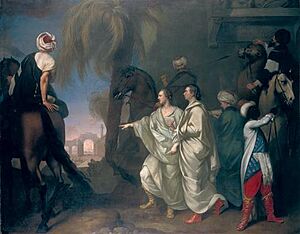James Dawkins (antiquarian) facts for kids
Quick facts for kids
James Dawkins
|
|
|---|---|

Print of James Dawkins in the Abingdon School archives
|
|
| Born | 1722 |
| Died | 1757 |
James Dawkins (born in 1722 in Jamaica, died on September 6, 1757, in Jamaica) was an important figure in British history. He was a member of the British Parliament, a historian who studied old things (called an antiquarian), and a supporter of the Jacobite cause. His family owned large sugar plantations in Jamaica, where enslaved people were forced to work.
Early Life and Education
The Dawkins family moved to Jamaica shortly after Britain took control of the island from Spain in 1655.
James was the oldest son of Henry Dawkins I (1698–1744). Henry was a very rich sugar planter and owned many enslaved people in Clarendon, Jamaica. James's mother was Elizabeth (1697?–1757). Her father, Edward Pennant, was the chief judge of Jamaica. James also had two younger brothers, William and Henry II.
James went to England for his schooling. He attended John Roysse's free school in Abingdon (now Abingdon School). Later, he went to St John's College, Oxford in 1739. When his father died in 1744, James inherited a huge amount of land, about 14,300 acres. This included several large plantations like Parnassus Estate and Dawkins Caymanas.
James finished his studies and earned a special law degree (DCL) in 1749.
Career and Discoveries

After college, James went on a long trip through Europe, called a "Grand Tour." He visited Paris and Rome, where he met other people who supported the Jacobite cause. He also met an experienced traveler named Robert Wood.
On May 5, 1750, Wood, Dawkins, their friend John Bouverie, and an Italian artist named Giovanni Borra started a journey. They traveled by ship from Naples to explore ancient sites around the Aegean Sea, Asia Minor, Egypt, Syria (including the famous ruins of Palmyra and Baalbek), Tripoli, and Cyprus. They returned to Naples in June 1751.
When they came back to England, James Dawkins helped pay for Robert Wood's books about their discoveries. He also supported the publication of The Antiquities of Athens by James Stuart and Nicholas Revett. Because of his interest in ancient history, James was chosen to join the Society of Dilettanti in 1755. This was a group of people who loved art and ancient Greek and Roman culture.
In May 1753, Dawkins traveled to Berlin to meet Frederick the Great, the King of Prussia. He was trying to get the King's help for the Jacobite cause, which was a political movement to bring back the Stuart family to the British throne. The British government was not happy about this. They issued a warrant for Dawkins's arrest when he returned to England in 1754, but he was not arrested.
Once back in England, he bought an estate in Laverstoke. He was also elected as a Member of Parliament (MP) for the area of Hindon. He served as an MP from 1754 until his death in 1757. James also owned a very large plantation in Jamaica, called Sutton's Plantation, with his brother Henry. This plantation was about 25,000 acres.
James Dawkins died in Jamaica in 1757. He was not married. He was first buried on his Old Plantation in Clarendon. Later, in 1922, his and his parents' remains were moved to St Paul's Church in Chapelton, Jamaica, when the family's estates were sold.

